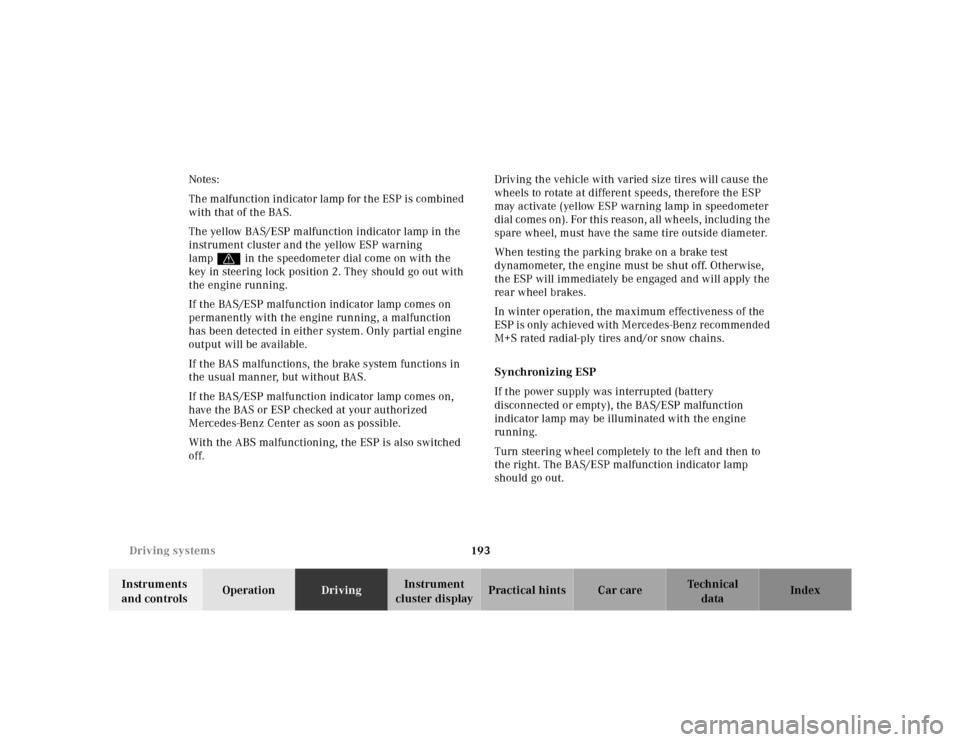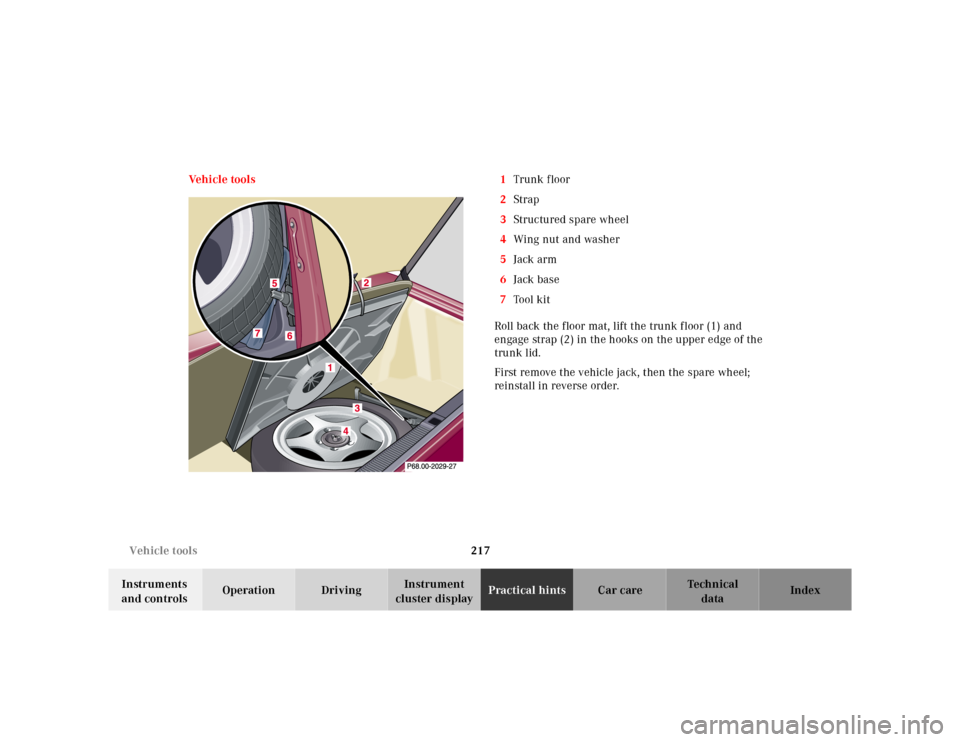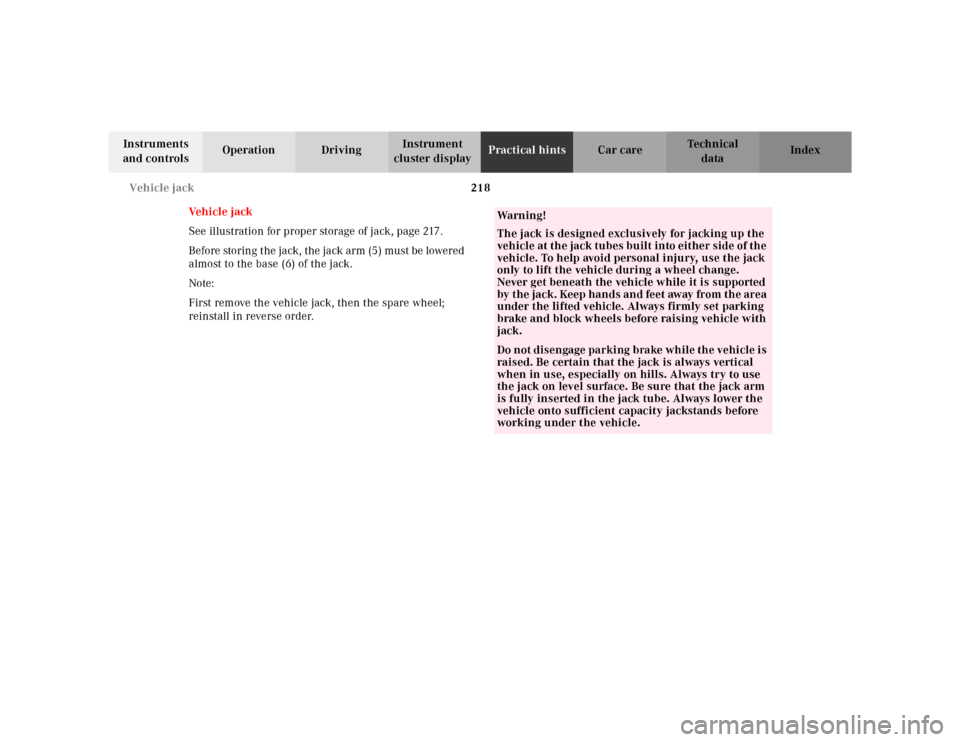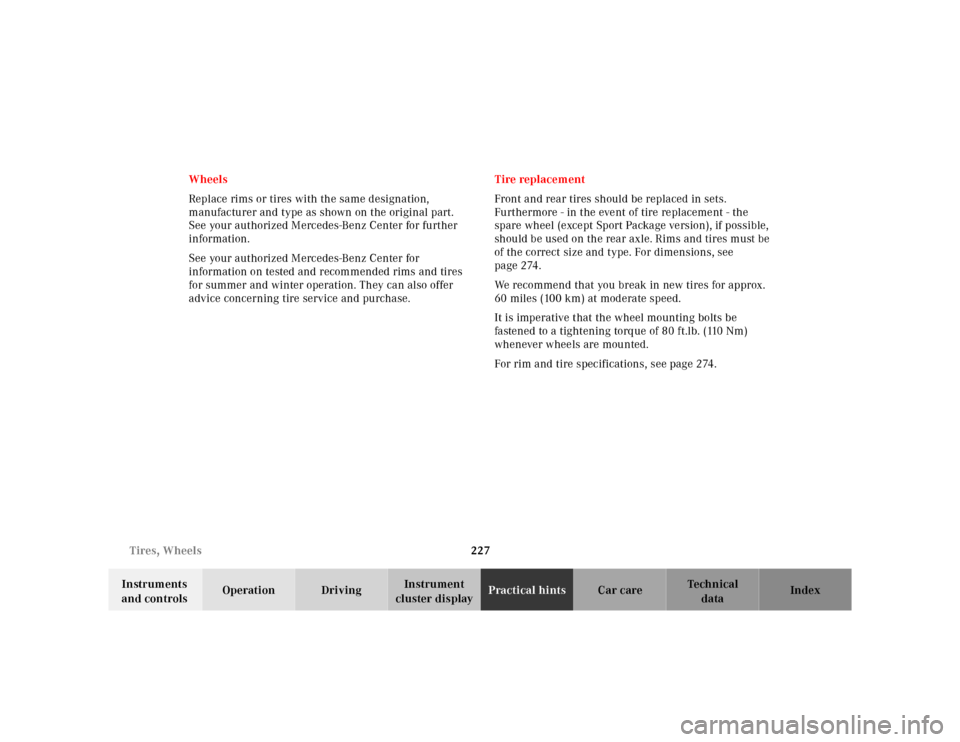2002 MERCEDES-BENZ SL500 spare wheel
[x] Cancel search: spare wheelPage 8 of 302

5 Contents
Practical hints First aid kit ..................................... 216
Stowing things in the vehicle ...... 216
Vehicle tools .................................... 217
Vehicle jack ..................................... 218
Fuses ................................................ 219
Hood .................................................220
Automatic transmission
fluid level ...................................222
Checking engine oil level .............222
Coolant level ...................................224
Adding coolant ...............................225
Windshield and
headlamp washer
fluid mixing ratio ......................226
Wheels .............................................227
Tire replacement ............................227
Rotating wheels ..............................228
Spare wheel ....................................229
Changing wheels ........................... 231
Tire inflation pressure ..................235
Battery .............................................237
Battery Recycling .......................238Jump starting ................................. 239
Towing the vehicle ........................ 241
Exterior lamps ............................... 243
Headlamp assembly
(Halogen) .................................... 244
Taillamp assemblies .................. 250
Changing batteries in the
remote control ........................... 252
Synchronizing ............................ 253
Raising soft top manually ............ 254
Replacing wiper blade ................. 258
Manual release of
fuel filler flap ............................ 260
Trunk lamp ..................................... 260
Vehicle care Cleaning and care
of the vehicle ............................. 262
Power washer ............................. 263
Tar stains .................................... 263
Paintwork, Painted Body
Components ................................ 263
Engine cleaning ......................... 264
Vehicle washing ......................... 264Ornamental moldings ................264
Headlamps, taillamps,
turn signal lenses ......................264
Window cleaning .......................265
Light alloy wheels ......................265
Instrument cluster .....................265
Steering wheel and
gear selector lever ......................265
Cup holder ...................................265
Seat belts .....................................266
Headliner, shelf behind
roll bars, and other hard
plastic trim items .......................266
Soft top .........................................266
Headliner .....................................267
Wind screen ................................267
Automatic antenna .....................267
Wiper blade .................................267
Headlamp cleaning
system ..........................................267
Leather upholstery .....................268
Plastic and rubber parts ............268
Illuminated door sill panels .....268
Page 197 of 302

193 Driving systems
Te ch n ica l
data Instruments
and controlsOperationDrivingInstrument
cluster displayPractical hints Car care Index Notes:
The malfunction indicator lamp for the ESP is combined
with that of the BAS.
The yellow BAS/ESP malfunction indicator lamp in the
instrument cluster and the yellow ESP warning
lampv in the speedometer dial come on with the
key in steering lock position 2. They should go out with
the engine running.
If the BAS/ESP malfunction indicator lamp comes on
permanently with the engine running, a malfunction
has been detected in either system. Only partial engine
output will be available.
If the BAS malfunctions, the brake system functions in
the usual manner, but without BAS.
If the BAS/ESP malfunction indicator lamp comes on,
have the BAS or ESP checked at your authorized
Mercedes-Benz Center as soon as possible.
With the ABS malfunctioning, the ESP is also switched
off.Driving the vehicle with varied size tires will cause the
wheels to rotate at different speeds, therefore the ESP
may activate (yellow ESP warning lamp in speedometer
dial comes on). For this reason, all wheels, including the
spare wheel, must have the same tire outside diameter.
When testing the parking brake on a brake test
dynamometer, the engine must be shut off. Otherwise,
the ESP will immediately be engaged and will apply the
rear wheel brakes.
In winter operation, the maximum effectiveness of the
ESP is only achieved with Mercedes-Benz recommended
M+S rated radial-ply tires and/or snow chains.
Synchronizing ESP
If the power supply was interrupted (battery
disconnected or empty), the BAS/ESP malfunction
indicator lamp may be illuminated with the engine
running.
Turn steering wheel completely to the left and then to
the right. The BAS/ESP malfunction indicator lamp
should go out.
Page 219 of 302

215 Contents - Practical hints
Te ch n ica l
data Instruments
and controlsOperation DrivingInstrument
cluster displayPractical hintsCar care Index
Practical hints First aid kit ..................................... 216
Stowing things in the vehicle ...... 216
Vehicle tools .................................... 217
Vehicle jack ..................................... 218
Fuses ................................................ 219
Hood .................................................220
Automatic transmission
fluid level ...................................222
Checking engine oil level .............222
Coolant level ...................................224
Adding coolant ...............................225Windshield and
headlamp washer
fluid mixing ratio ..................... 226
Wheels ............................................ 227
Tire replacement ........................... 227
Rotating wheels ............................. 228
Spare wheel .................................... 229
Changing wheels ........................... 231
Tire inflation pressure ................. 235
Battery ............................................. 237
Battery Recycling ....................... 238
Jump starting ................................. 239
Towing the vehicle ........................ 241Exterior lamps ................................243
Headlamp assembly
(Halogen) .....................................244
Taillamp assemblies ..................250
Changing batteries in the
remote control ...........................252
Synchronizing ............................253
Raising soft top manually .............254
Replacing wiper blade .................258
Manual release of
fuel filler flap .............................260
Trunk lamp .....................................260
Page 221 of 302

217 Vehicle tools
Te ch n ica l
data Instruments
and controlsOperation DrivingInstrument
cluster displayPractical hintsCar care Index Vehicle tools 1Trunk f loor
2Strap
3Structured spare wheel
4Wing nut and washer
5Jack arm
6Jack base
7To o l k i t
Roll back the floor mat, lift the trunk floor (1) and
engage strap (2) in the hooks on the upper edge of the
trunk lid.
First remove the vehicle jack, then the spare wheel;
reinstall in reverse order.
Page 222 of 302

218 Vehicle jack
Te ch n ica l
data Instruments
and controlsOperation DrivingInstrument
cluster displayPractical hintsCar care Index
Ve h i c l e j a c k
See illustration for proper storage of jack, page 217.
Before storing the jack, the jack arm (5) must be lowered
almost to the base (6) of the jack.
Note:
First remove the vehicle jack, then the spare wheel;
reinstall in reverse order.
Wa r n i n g !
The jack is designed exclusively for jacking up the
vehicle at the jack tubes built into either side of the
vehicle. To help avoid personal injury, use the jack
only to lift the vehicle during a wheel change.
Never get beneath the vehicle while it is supported
by the jack. Keep hands and feet away from the area
under the lifted vehicle. Always firmly set parking
brake and block wheels before raising vehicle with
jack.Do not disengage parking brake while the vehicle is
raised. Be certain that the jack is always vertical
when in use, especially on hills. Always try to use
the jack on level surface. Be sure that the jack arm
is fully inserted in the jack tube. Always lower the
vehicle onto sufficient capacity jackstands before
working under the vehicle.
Page 231 of 302

227 Tires, Wheels
Te ch n ica l
data Instruments
and controlsOperation DrivingInstrument
cluster displayPractical hintsCar care Index Wheels
Replace rims or tires with the same designation,
manufacturer and type as shown on the original part.
See your authorized Mercedes-Benz Center for further
information.
See your authorized Mercedes-Benz Center for
information on tested and recommended rims and tires
for summer and winter operation. They can also offer
advice concerning tire service and purchase.Tire replacement
Front and rear tires should be replaced in sets.
Furthermore - in the event of tire replacement - the
spare wheel (except Sport Package version), if possible,
should be used on the rear axle. Rims and tires must be
of the correct size and type. For dimensions, see
page 274.
We recommend that you break in new tires for approx.
60 miles (100 km) at moderate speed.
It is imperative that the wheel mounting bolts be
fastened to a tightening torque of 80 ft.lb. (110 Nm)
whenever wheels are mounted.
For rim and tire specifications, see page 274.
Page 233 of 302

229 Tires, Wheels
Te ch n ica l
data Instruments
and controlsOperation DrivingInstrument
cluster displayPractical hintsCar care Index Notes:
Thoroughly clean the inner side of the wheels any time
you rotate the wheels or wash the vehicle underside.
The use of retread tires is not recommended. Retread
tires may adversely affect the handling characteristics
and safety of the vehicle.
Dented or bent rims can cause tire pressure loss and
damage to the tire beads. For this reason, check rims for
damage at regular intervals. The rim f langes must be
checked for wear before a tire is mounted. Remove
burrs, if any.
Check and ensure proper tire inflation pressure after
rotating the wheels. For tire inflation pressure see
page 235.Spare wheel
(except Sport Package)
The spare wheel rim size is 8
1/4 J x 17 H2.
In the case of a f lat tire, or breakdown, you may
temporarily use the spare wheel.
Unid irectional tires must a lways be mou nted w it h a rrow
on tire sidewall pointing in direction of vehicle forward
movement.
If the arrow on tire sidewall does not point in direction
of vehicle forward movement when using the spare
wheel, observe the following restrictions:
• Drive to the nearest repair facility to have the flat
tire repaired or replaced as appropriate.
• Do not operate vehicle with more than one spare
wheel mounted.
For additional information, refer to page 274.
Wa r n i n g !
The spare wheel rim is for temporary use only. Use
for over a total of 12 000 miles (20 000 km)
(aggregate of all uses) may cause wheel rim failure
leading to an accident and possible injuries.
Page 234 of 302

230 Tires, Wheels
Te ch n ica l
data Instruments
and controlsOperation DrivingInstrument
cluster displayPractical hintsCar care Index
Spare Wheel
(with Sport Package)
The spare wheel rim size is 8
1/4 J x 17 H2 with tire size
245/45 R 17 95W.
In the case of a f lat tire or breakdown, you may
temporarily use the spare wheel.
Unidirectional tires must always be mounted with arrow
on tire sidewall pointing in direction of vehicle forward
movement. If the arrow on tire sidewall does not point
in direction of vehicle forward movement when using
the spare wheel, observe the following restrictions:
• Do not exceed vehicle speed of 50 mph (80 km/h).
• Drive to the nearest repair facility to have the flat
tire repaired or replaced as appropriate.
• Do not operate vehicle with more than one spare
wheel mounted.
For additional information, refer to page 274.
Wa r n i n g !
The spare wheel rim is for temporary use only. Use
for over a total of 12 000 miles (20 000 km) may
cause wheel rim failure leading to an accident and
possible injuries. The dimensions of the spare wheel are different
from those of road wheels. As a result, the vehicle
handling characteristics change when driving with
a mounted spare wheel.The spare wheel should only be used temporarily,
and replaced with a regular road wheel as quickly
as possible.